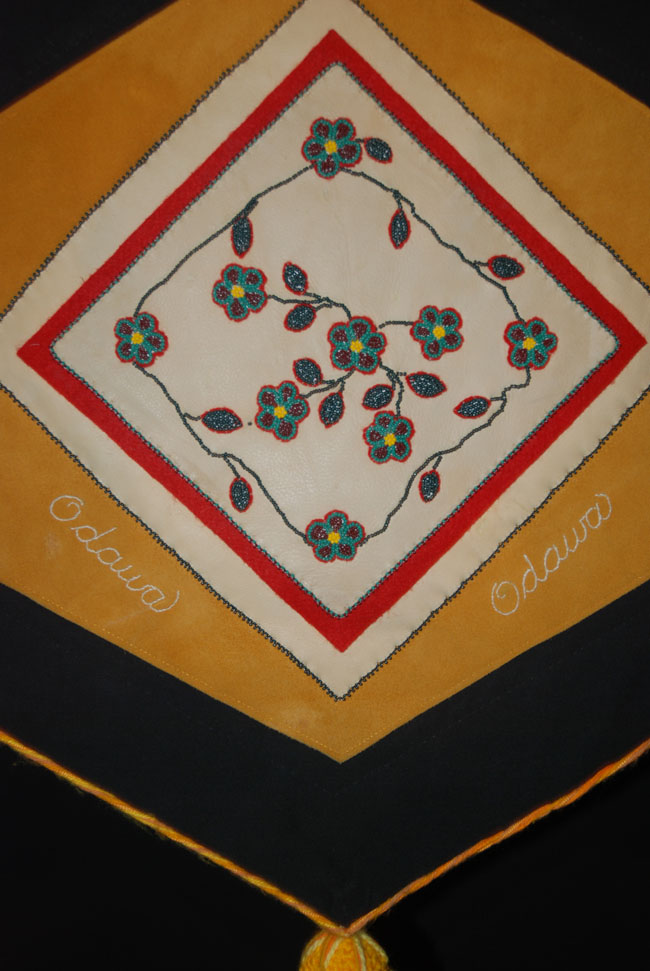Quilt connects peoples from across the world in every stitch

By Melissa Cooper
WIIKWEMKOONG UNCEDED TERRITORY – For those not very interested in quilting and sewing, much deeper learning was to be embraced at the Quilt of Belonging showcase which was held from September 13-17 at the Debajemujig’s Creation Centre in Manitowaning.
“I felt like I was in the room with all those people who put into it – I could just feel the energy,” said Zach Cywink, Grade 12 Wikwemikong Wasse-Abin High School (WAHS) student who had a tour with Ms. O’Leary’s Art class. “It was awesome!”
The 120 foot (36 metre) long quilt portrays the rich cultural legacies of all the First Peoples in Canada and every nation of the world.
“Next to food belonging is the most crucial issue,” said Esther Bryan, Quilt of Belonging Director who had created and designed this project from her home in Williamstown, ON.
The Quilt of Belonging consists of 263 squares, representing 71 Aboriginal groups and 192 immigrant nationalities found in Canada. Each square, or “block” was created by hand by volunteers.
“I designed it, worked with everyone and wrote the book,” Bryan said.
The quilt tells of inspiration, of deeper meaning, of much pride in workmanship and history.
Before development of the quilt began, Bryan recalls making a return trip with her father to Slovakia in 1994 in search of the family they had left behind. The reasons for her particular upbringing were clearer afterward and as a result of this upon her return back to Canada she embraced more of a humanitarian effort with her life.
“I know why he (my father) pushed for an education for me,” Bryan said as she shared aspects of her 1994 trip. “My father had such love and compassion.”
For 2014 the quilt has been showcased at three different locations, but has been on display through Canada since April of 2005 making its initial debut at the Canadian Museum of Civilization in Gatineau, Quebec.
“First Nations pride of place and heritage, that’s why the theme of this project is a place for all,” she said. “God makes people all shapes, sizes, races and abilities.”
“This is what this quilt of belonging was designed to show. We used cultural identities to show how unique everyone is – what matters in life.” Bryan added.
On the foundation wall of the quilt are all First Nations, Metis, Inuit quilters.
“It has been a huge factor is giving the Aboriginal peoples the respect,” Bryan said. “Having them as the foundation wall cradles the piece.”
Two of the quilters hail from Wiikwemkoong Unceded Territory on Manitoulin Island. Shirley Pitawanakwat produced the Odawa piece and Marlene Shawana created the Ojibwe one.
“It was back in 1998 or ’99 when I made that quilt square – it was so awesome to see it as part of this (quilt show),” said Shirley Pitawanakwat. “I made the design out of nature colors (reddish brown and green) with the beads, felt and deer hide and joined the flowers together with a vine. In making it I borrowed from my grandmothers design (Liza Aminikwam) – a simple flower design she used to use in making her crafts such as place mats.”
The artistry pieces of the quilt were not meant to feature works of those that are the best and brightest or most famous quilters.
“There’s disabled people, children as young as two in this,” said Bryan.
As for how she came across each of the individual contributors, Bryan went to find them.
“I went to immigration centres, multi-cultural festivals, on the street, on the media to find them,” she said. “This teaches children that each one have something to give and have that sense of self-worth. Need to be able to accept other peoples that are different from them as many have gone through the same kinds of issues.”
The only exclusions on what design elements couldn’t be used in the sewing of the 11-inch fabric squares were that of maps, and flags as these political elements can change with time.
Aside from the shows and the website, a book also further tells the story of how the quilt came into being. The 296 page full-color book, entitled: “Quilt of Belonging: The Invitation Project” was published in 2005 by Esther Bryan and Friends and it’s in its 4th printing, slightly revised over time. That along with a DVD and educational materials are available for order through www.quiltofbelonging.ca
“It’s such a great opportunity to have her here with this quilt,” said Joshua Peltier, Debajemujig employee on the last day of the Island’s display.
The question about the future of the quilt, when the tour ends and or details of where the giant quilts final home will be are still being worked on.


